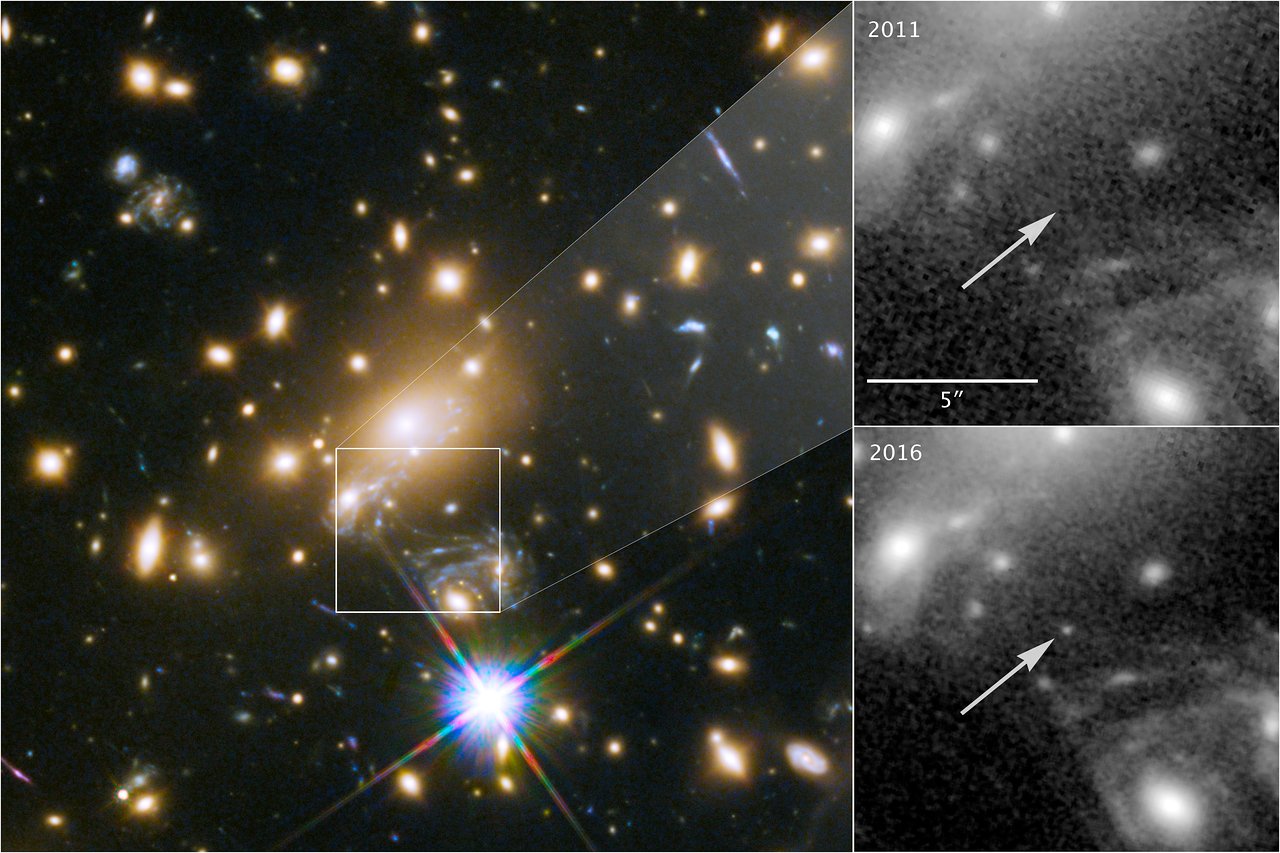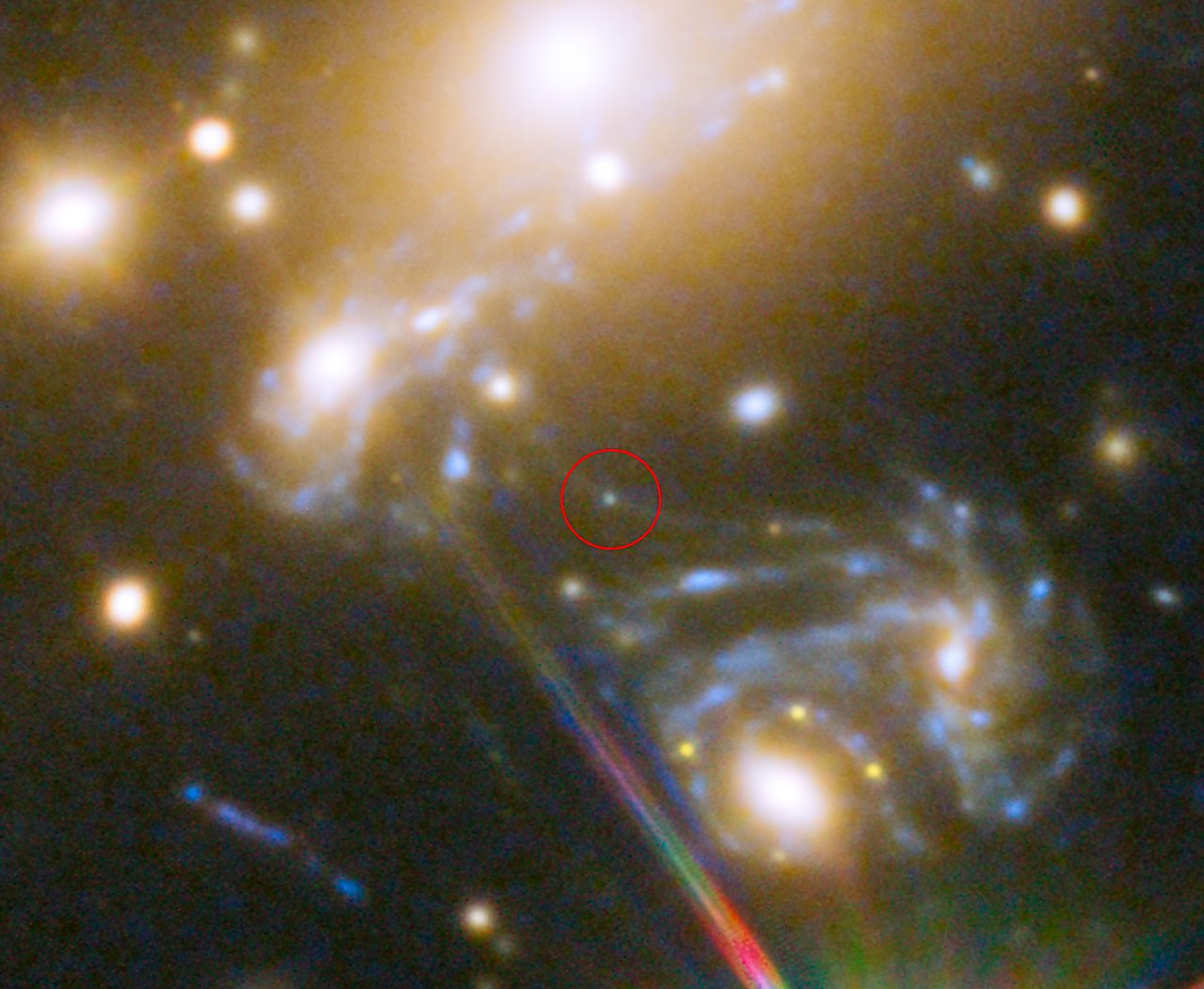Rare Cosmic Alignment Reveals Most Distant Star Ever Seen
The Hubble Space Telescope has broken yet another observing record: The famed observatory has found the most distant "ordinary" star ever observed, at an astounding 9 billion light-years from Earth — which means the light scientists see started traveling at least 9 billion years ago. By comparison, the age of the universe is roughly 13.8 billion years.
Normally, stars that far away are too difficult to make out individually; a galaxy or a supernova (star explosion) is much easier to see. But this particular star — classified as an ordinary star, meaning a star on the main sequence of evolution that is fusing hydrogen into helium — came to light thanks to a rare alignment, researchers reported in a new study. When a main sequence star ceases burning the hydrogen at its core, it leaves the main sequence. This leads to a range of different outcomes for stars. Commonly, larger stars off the main sequence explode into supernovas, while smaller stars collapse into white dwarfs.
Astronomers found the star, which is nicknamed Icarus, through gravitational lensing. This phenomenon refers to how a massive galaxy cluster or other object can bend light from objects behind it, making dim objects much brighter from Earth's perspective. [In Photos: Cosmic Lenses Reveal Expansion of the Universe]
Usually, this lensing process can magnify objects by up to 50 times, but astronomers got lucky here: The newfound star was magnified more than 2,000 times because a star was briefly passing through the line of sight between Hubble and Icarus, researchers said in a statement from the University of California, Berkeley. This rare glimpse of a faraway star could provide a window into how stars in general evolve, especially those that are extremely luminous, the team said.

"You can see individual galaxies out there, but this star is at least 100 times farther away than the next individual star we can study, except for supernova explosions," lead study author Patrick Kelly said in the statement. Kelly was a postdoctoral scholar at the University of California, Berkeley when he worked on the research but is currently on the faculty at the University of Minnesota.
Icarus, known more formally as MACS J1149 Lensed Star 1 (LS1), showed up as Kelly was following up on a supernova, called SN Refsdal, that he discovered in 2014. The supernova was discovered using a gravitational lens in the constellation Leo; the lens was formed by a galaxy cluster known as MACS J1149+2223.
"For the first time ever, we're seeing an individual normal star — not a supernova, not a gamma-ray burst, but a single stable star — at a distance of nine billion light-years," study co-author Alex Filippenko, an astronomer at UC Berkeley, said in the same statement. These lenses are amazing cosmic telescopes."
Get the Space.com Newsletter
Breaking space news, the latest updates on rocket launches, skywatching events and more!
Kelly's team examined the colors coming from Icarus' light and found that it was a blue supergiant. This kind of star is more massive and larger than our sun, shining up to hundreds of thousands of times brighter. Still, Icarus was so far away that astronomers never would have spotted it without powerful lensing. Kelly suspected the star was far more magnified than the supernova — a hypothesis later borne out by modeling.
"By modeling the lens, they [astronomers] concluded that the tremendous apparent brightening of Icarus was probably caused by a unique effect of gravitational lensing," UC Berkeley representatives said in the statement. "While an extended lens, like a galaxy cluster, can only magnify a background object up to 50 times, smaller objects can magnify much more.
"A single star in a foreground lens, if precisely aligned with a background star, can magnify the background star thousands of times," they added. "In this case, a star about the size of our sun briefly passed directly through the line of sight between the distant star Icarus and Hubble, boosting its brightness more than 2,000 times."

Fortunately for astronomers, Icarus is well placed for more of these alignments. As stars in the cluster MACS J1149+2223 move around, the brightness of Icarus could be increased as much as 10,000 times during other lensing events. Astronomers might be able to catch more of these rare events in general if they look in the right location, the team added.
"There are alignments like this all over the place as background stars or stars in lensing galaxies move around, offering the possibility of studying very distant stars dating from the early universe, just as we have been using gravitational lensing to study distant galaxies," Filippenko said in the statement. "For this type of research, nature has provided us with a larger telescope than we can possibly build."
Icarus showed up in Hubble images taken between April 2016 and April 2017. A second star appeared in some observations that could be either a mirror image of Icarus or yet another star being gravitationally lensed.
Astronomers also probed dark matter — a little-understood substance that makes up most of the universe — with observations of Icarus. In contrast to what some previous theories had stated, the new observations suggest that dark matter is not made up of primordial black holes within galaxy clusters.
The new work was detailed today (April 2) in the journal Nature Astronomy.
Follow us @Spacedotcom, Facebook and Google+. Original article on Space.com.
Join our Space Forums to keep talking space on the latest missions, night sky and more! And if you have a news tip, correction or comment, let us know at: community@space.com.

Elizabeth Howell (she/her), Ph.D., was a staff writer in the spaceflight channel between 2022 and 2024 specializing in Canadian space news. She was contributing writer for Space.com for 10 years from 2012 to 2024. Elizabeth's reporting includes multiple exclusives with the White House, leading world coverage about a lost-and-found space tomato on the International Space Station, witnessing five human spaceflight launches on two continents, flying parabolic, working inside a spacesuit, and participating in a simulated Mars mission. Her latest book, "Why Am I Taller?" (ECW Press, 2022) is co-written with astronaut Dave Williams.









